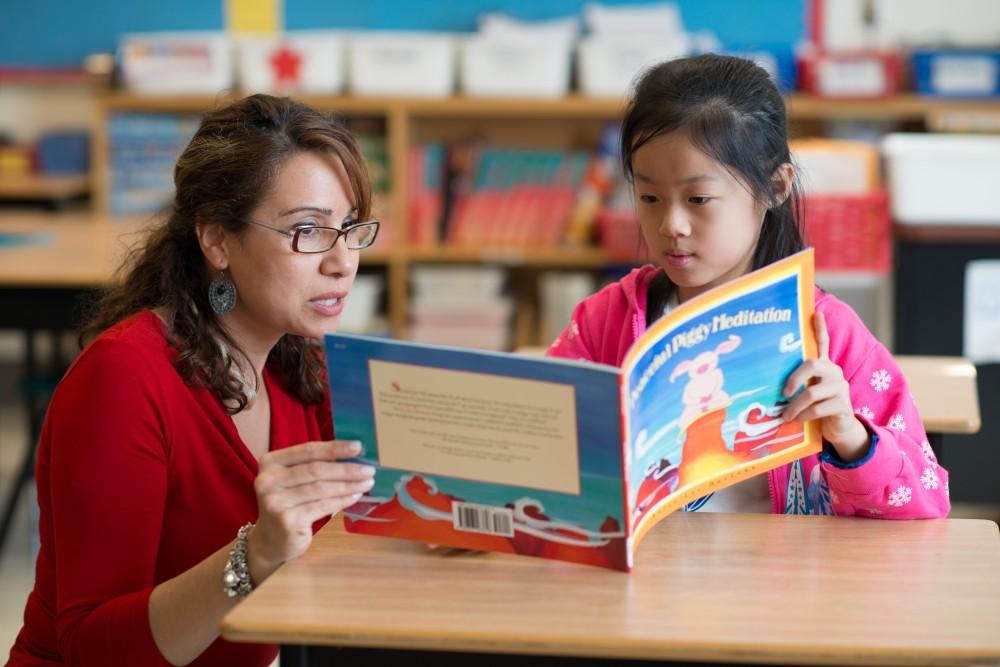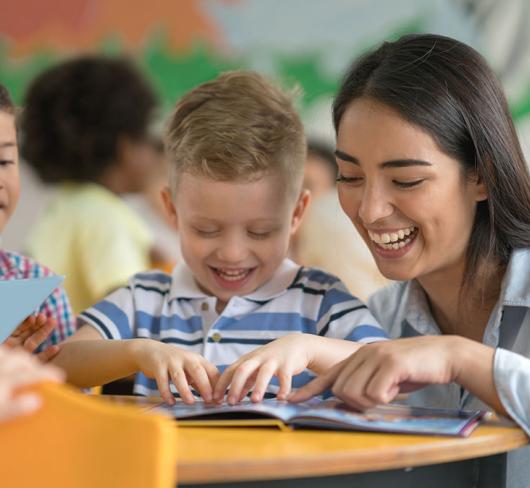
Learning Life Skills through Picture Books
Every day, my Grade 2 students come into the classroom with smiles on their faces and a question on their minds: “Whose bucket will I fill today?” The children join me on the carpet as I take the attendance. They are eager to share how they plan to fill each other’s bucket. This concept came from the picture book by Carol McCloud called Have You Filled a Bucket Today? and emphasizes authentic community service. Emily says, “I want to fill Elaine’s bucket by helping her with her spelling.” Daniel says, “I am going to fill your bucket, Ms. Y., by being a good listener.” As some students share how they would care for others, more hands go up. The quiet ones now have something to share and are eager to help out. One student says, “I will make sure that our class library is organized.” Another says, “I will say thank you to those who help me with my work.” One by one, the students share their ideas. The positive energy created in the classroom is palpable and this energy has become our “code of behaviour.” We set our intention each morning to do our personal best … no bucket dipping allowed!
Since the first week of September we have been using The Journey to Excellence program in our classroom. The Journey to Excellence is a uniquely different character education program that teaches children the true meaning of “personal best.” It develops a child’s self-esteem by teaching character from the inside out. The Journey to Excellence consists of seven life skills that, when explicitly taught, build a child’s self-awareness, self-appreciation and self-love. Students are invited on a journey of exploration to uncover their unique qualities, passions and talents. This exploration begins in Kindergarten and continues throughout their school career. The seven life skills are not an “add-on” to the curriculum. After the skills are explicitly taught, they are easily integrated into all areas of the curriculum. Students are encouraged to build a portfolio to house personal artifacts and activities completed throughout the year. The integration of the seven life skills creates a positive emotional climate within the child, within the classroom and within the school community.
The seven life skills in The Journey to Excellence program include
- Uniqueness
- Intuition
- Reflection
- Visualizing
- Goal-Setting
- Mentors
- Community Service
These skills are easily woven into my literacy block by using picture books such as those suggested in this article or offered in the comprehensive list included in the program. The list is organized in seven sections to include each life skill, and the books are readily available in most school libraries. These picture books deliver rich and meaningful content about the life skills, while simultaneously teaching the literacy skills in my lesson plan each day, such as making predictions, inferring and identifying the author’s message.
On the first day, I chose the book Zero by Kathryn Otosho to introduce “Uniqueness,” the first life skill. Uniqueness is the first of the seven skills because it is the foundation skill that supports the other six skills. Two key concepts represent Uniqueness. These concepts are “one of a kind” and “irreplaceability.” Through these concepts, children begin to explore their unique nature and learn to appreciate their value and importance in the world. Self-love and self-appreciation are the desired outcomes of explicitly teaching and practising the skill of Uniqueness. The students recognized the message in the story Zero and made connections to their own lives with confidence. Zero learned that he had value and helped his friends to be great. “That is the kind of friend I want to be,” said Mohammed. “Personal best is about becoming the best me I can be!” added Sarah.
I chose the books The Way I Feel by Janan Cain and Howard B. Wigglebottom Listens to His Heart by Howard Binkow to introduce the second life skill, “Intuition.” Intuition is the second life skill because it is an important part of the successful application of the other six skills. Intuition has two key concepts. These concepts are “sixth sense” and “emotional guidance system.” Developing a sixth sense, often described as a “gut feeling,” is an essential tool for personal safety, decision-making and critical thinking. Before reading Howard B. Wigglebottom Listens to His Heart, I shared The Way I Feel and we had a discussion about emotions. Through these two books, students learned that their intuition and emotions work together to guide and protect them.
The function of our emotional guidance system is to assist us when making decisions. I asked the children to help me build an anchor chart showing what they already know about Intuition. Students who had participated in the program the previous year were eager to share. Concepts such as “authenticity” and “gut feeling” were included on our chart. After sharing the story Howard B. Wigglebottom Listens to His Heart, we had a discussion about the author’s message and the children wrote a response in their journals. Zoya raised her hand and said, “Howard felt sad when he listened to his friends and stopped dancing. When he ignored the peer pressure of his friends and started dancing again he felt happy. His gut feeling told him to be a dancer because that is what makes him happy inside, even if his friends didn’t think he could dance. In the end, he was happy with his choice and his friends learned to dance too.”
I introduced “Reflection,” the third life skill, by reading the picture book called A Quiet Place by Douglas Wood. It highlights the importance of “unplugging” from technology and planning unscheduled relaxation time each day. Reflection has two key concepts: “stress management” and “quiet time.” After recess one day, Marco came into the classroom angry. He took some reflective time for himself at his desk. I watched him close his eyes and take some deep breaths. Marco knows that reflective time allows him to tune into his intuition to see how he is feeling. He can then choose an activity that calms him down. Marco pulled out his journal and coloured a picture. It wasn’t long before he could rejoin the larger group.
I introduced the fourth and fifth life skills, “Visualizing” and “Goal-Setting,” at the same time because they are best taught together. I read the picture book called Me Jane by Patrick McDonnell, a beautiful biography about the life of Jane Goodall, the renowned primatologist. This empowering story highlights the importance of discovering your passions early in life and then finding a way to turn a passion into your future work by setting authentic goals. The key concept for Visualizing is “thoughts are things.” The key concept for Goal-Setting is “action plan.” Children learn that their minds are powerful tools and that they can direct their minds toward their goals by the thoughts they think and the actions they take.
It was November and our class was preparing a presentation for our upcoming Remembrance Day assembly. Using Visualizing and Goal-Setting to guide us, the children were asked to visualize a peaceful world and describe their vision by using their five senses. Natalie shared a picture of a peaceful world and wrote underneath, “When we all work hard to do our personal best, everyone is happy.” Our follow-up discussion and sharing time led us to the introduction of our last two life skills.
“Mentors,” the sixth life skill and “Community Service,” the seventh life skill, are all about being your personal best in the community. The key concept for Mentors is that “behind every successful person there is a mentor.” The key concept for Community Service is that “sharing your unique gifts and talents with others fills everyone’s bucket and makes the world a better place for everyone.” We created an anchor chart for these life skills that highlighted all the ways that each student could help others in the class, just by being their personal best. Carrie made the connection to our story, Have You Filled a Bucket Today? She said, “When my bucket is full, I feel more peaceful inside. I don’t want to fight with anyone.” We focused on peace that day and every school day after that. We all agreed that love for ourselves and others is the best way to create peace in the world.
The seven life skills inform my choice of content when selecting books and units of study to teach the curriculum. I now look for literature that encourages critical thinking, is thoughtful and has meaningful life lessons. Meaningful content allows me to cover the curriculum and build character at the same time. After three months at school, The Journey to Excellence has changed from the explicit teaching of the seven life skills to more of a mindset for me as the teacher. It guides my approach to delivering the curriculum to my students every day. I now see countless opportunities to teach life lessons alongside my academic lessons so that the students in my classroom are growing not only academically, but also socially and emotionally. The life skills have become a powerful tool kit for all of us. Doing our personal best for others and ourselves has become our number one goal, and for me it has also become my antidote for behaviour problems and bullying in my classroom.
I have been applying the seven life skills in my personal life too. It is hard not to. As I teach these life lessons, I notice that I also become a student. Personal growth has been an unexpected benefit as I practise what I am teaching both inside and outside of the classroom. I have become a more effective teacher, parent and friend. I find I have more confidence and courage to speak my mind and follow my heart. Being a good role model means practising what I teach. When my students are feeling down and think they can’t achieve their goals, I remind them that they are one of a kind. Their knowledge of their own uniqueness empowers them and me to do our personal best at home, at school and in our community.
****
Amy Evans is a member of the York Region Teacher Local. She was the recipient of the ETFO Writer’s Award for her program The Journey to Excellence in 2012. This program can help support the implementation of Creating Pathways to Success: An Education and Career/Life Planning Program for Ontario Schools, published by the Ontario Ministry of Education in 2013. You can connect with Amy and find out more about The Journey to Excellence at amyevans.ca.

